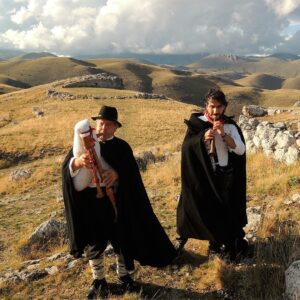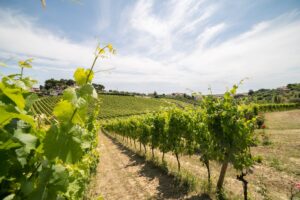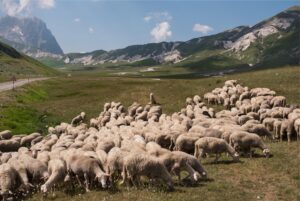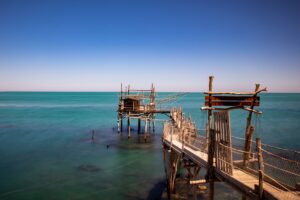The sounds of crying, desperate prayers and the unhinged ramblings of people on the verge of madness faded into the background as the cover of night helped to lull the wounded “traitor” to sleep. As he dreamt, he was transported to the soothing sounds of the sea then his dream would quickly transport him to a lush forest accompanied by sounds of the breeze rustling through the trees until finally, his dreaming state settled into a place where he would experience the best sounds of all: his family harvesting wine grapes in their vineyards. But within a blink of an eye, he woke as the sun began to rise and the door of the cattle car, which he was shoved into the day before, was being opened. More people were being pushed into the car until it was at about 200% capacity with people gasping for air and as the people were crushed into the “traitor”, a stabbing pain reminded him of his cracked ribs that were a parting gift from the Nazi soldiers who initially forced him into the cattle car the day before.
As people in the car began to faint, many started begging the Nazi soldiers to spray the cars with water but there would be no such luck. It was a grueling ride but the “traitor” tried to inundate his mind with the picturesque memories of his home in the Italian region of Abruzzo. His memories of numerous nature hikes he took along the rolling hills, accented with wild, colorful poppy flowers, where he had sat and quietly watched the multitude of creatures, brought him a slight sense of peace. But then one memory aggressively latched onto his mind, deeply unsettling any sense of tranquility: the time he witnessed an eagle soaring through the air with its massive wingspan – a wingspan that seemed more prominent than the “traitor” himself. How he wished he was that eagle at that moment.
Once the cattle car came to a complete stop and the exodus from the car began, he knew that this was his chance, his only chance to try to break free. He felt that this would be his only shot to survive as he had a feeling that the place where the Nazi soldiers were taking them would be a greater hell than death itself. He quickly bolted through the crowd, hearing screams from the soldiers. Still, he didn’t know if they were running after him or other people and he just kept running, running faster than he had ever before, feeling as if he was that eagle in that instance, until he was nowhere near any other human beings. He eventually found out that he was being brought to a concentration camp in Poland. Now he needed to find his way back home, to Abruzzo, as the thought of having one more wine harvest party with his family and neighbors back home kept him going even in the bleakest of times, and there were many bleak times along the way.
Abruzzo Wine Region

Photo Credit: Consorzio Tutela Vini d’Abruzzo
When the Nazi German troops occupied Italy in 1943, they created a fascist government under Mussolini and the German army captured around 600,000 Italian soldiers, putting them in prisons and labor camps. The only way to be released from the prisons and camps was to join the German army and fight for fascism, but three-quarters of the imprisoned Italian soldiers rejected the offer, with many dying in jails or camps. The Nazis called the Italian soldiers who refused to fight for a fascist government “traitors”, and Laurentino De Cerchio was that young Italian soldier forced into a cattle car traveling to a labor camp in Poland, who desperately dreamt of his home in Abruzzo.
Eventually, Laurentino was able to make it home and he decided to throw himself into rebuilding his father-in-law’s wine estate, Torre Zambra in the Chieti province in Abruzzo. The war destroyed the vineyards so Laurentino had to start from scratch but with a greater focus on making quality wine. It took a couple of decades, but Torre Zambra bottled their first wine, instead of selling in bulk, in 1961. Over time, Laurentino bought more land in Abruzzo and other areas in Southern Italy to eventually build a well-respected family wine company.
After World War II, Italy’s economy was destroyed and instability rose as they had a divided society with much anger against the monarchy for endorsing a fascist regime. Through time the Italian Republic government superseded the monarchy, with some regions of Italy ultimately finding economic success with major industries building factories, creating more local jobs or creating more opportunities by finding wine export success that then helped to establish a tourism industry, such as Tuscany. In contrast, other regions just languished in obscurity.
Abruzzo was one of those hidden Italian wine gems that, in some ways, was significantly affected negatively by people struggling for decades in a poor region with few opportunities, yet in other ways, it has helped to garner its nicknames as “the greenest region in Europe” and “the green lung of Italy” as much of it is untouched. There are four major natural parks in Abruzzo, three national and one regional, that are home to around 1,700 plant species that account for 70% of the entire Italian flora that is found in the country; these parks are also hosts to 75% of Europe’s animal species and the region is broken up into two macroclimates: the continental climate found in the mountainous areas inland that make up around 65% of the region and the milder maritime climate in the coastal areas along the Adriatic Sea. And despite Piedmont taking most of the credit for Italian truffles, around 40% of Italian truffles come from Abruzzo.
White Wines of Abruzzo
In recent times, Abruzzo wine producers have found some success in their Montepulciano d’Abruzzo wines, although many confuse it with the Vino Nobile di Montepulciano reds from Tuscany, the latter made mainly from Sangiovese and comes from the town Montepulciano in Tuscany as opposed to the former being made from the Montepulciano red grape variety in Abruzzo. Although Abruzzo has made headway with their Montepulciano d’Abruzzo red wine, as it over-delivers for the price so it is an ideal wine to serve by the glass in restaurants, Abruzzo has a handful of impressive local white grapes. One of the white grapes that has become a darling of many sommeliers worldwide is the Pecorino white grape variety.
Due to one producer, Emidio Pepe, hardcore Italian wine connoisseurs are familiar with the prestigious legacy of Abruzzo white wines. One of the handful of local white grapes is Trebbiano d’Abruzzo. It is a specific clone, with enough genetic markers to make it a Trebbiano grape yet it has distinctive traits of its own and so this clone is very different from some other Trebbiano grapes that are grown to produce high yields to make quaffable wine. But Emidio Pepe goes to great lengths to grow concentrated, well-balanced Trebbiano d’Abruzzo grapes that make white wines that can easily age for up to 50 years, and hence, Trebbiano d’Abruzzo started to get its following and that was the only white grape that many Abruzzo producers wanted to grow; until an Abruzzo winemaker, named Cataldi Madonna, was the first in Italy to label a wine as Pecorino.
Pecorino
Surprisingly, Pecorino is believed to have originated within the boundaries of Abruzzo’s northern neighbor, the Marche region, still, no one can dispute that Abruzzo is part of the great success story of Pecorino. Like so many other lost native grapes, more high-yielding varieties took the place of Pecorino, a low-yielding grape, with it almost seeing its demise if it weren’t for key Marche and Abruzzo producers as well as sommeliers around the world being advocates for this white grape that has the same name as the much more well-known Pecorino Romano cheese. It is believed that the name “Pecorino” came from the sheepherders who would bring their flock of sheep from the mountains of Abruzzo to the southern region of Puglia during mid-September but the sheep would eat the Pecorino grapes hanging on the vines in the vineyards along the way. To compensate for the loss of the grapes, the sheepherders gave the vineyard owners some of their Pecorino cheese, which is how it is believed that the grape took on the same name as the sheep cheese.
The Pecorino white wine from Abruzzo has become quite the sommelier darling for many reasons; one apparent reason is that it is a familiar name because of the popularity of Pecorino Romano cheese but its range of floral, mineral, stone fruit and citrus fruit flavors combined with a nice amount of weight makes it a wonderful wine that can pair with a range of foods such as seafood, chicken and pork to name a few. Also, it offers value for those who seek out small producers making high-quality white wines as they are moderately priced while giving an authentic experience to the customer by introducing them to a native Italian grape variety that was almost lost.
Protected in Abruzzo
Considering the Pecorino grape variety’s low-yielding nature, it is remarkable that it survived in a region that struggled for so long with poverty as the wines of Abruzzo were underappreciated for so long and one would think any grape that couldn’t produce a decent quantity would have never survived. But just like Laurentino De Cerchio, who was able to survive against all odds, it is an example that there is something special at the core of Abruzzo people who go beyond mundane logic to protect what is vital to sustaining the values of their culture. And part of that incredible passion made Laurentino determined to make quality wine decades before there was even a market for Abruzzo premium wines.
It is pretty impressive when one thinks to what degree Abruzzo has not only kept their natural parks untouched but the perseverance of their culture. The first time someone sees one of the trabocchi structures in Abruzzo, it is like experiencing a fantastical dream beyond one’s comprehension as they marry the visual effects of spider webs with pulleys, ropes and wooden beams that giant wooden crabs seemingly control. But they were the most reliable way to fish along the Adriatic Coast as one could catch fish in all sorts of weather conditions without having to take a boat out, as the wooden platform brought one out to a structure where fishing could take place right in that spot. These trabocchi were common in many Italian regions along the coast but Abruzzo protected them by passing a law to conserve the trabocchi in Abruzzo. The fishing that took place on these trabocchi were an essential part of financial survival for many local families, and after World War II, they became an iconic architectural marvel for Abruzzo and today are a big tourist draw. Yet some trabocchi in Abruzzo are still used by multi-generational Abruzzo fishermen who proudly bring their grandchildren to show them the brilliant innovation of their people that goes back for centuries.
A little boy sitting on the end of the pier, as the sun warms his pinkish cheeks, watches his grandfather with an intensity that brings an awestruck look to his face as he knows one day he will take over this tradition from his grandfather. As the family gathered later that day for dinner, pouring the family wine from their vineyards into glasses, the grandfather once again sneaks his grandson a small taste of their wine while teaching him that the Abruzzo people, at all costs, protect those things that have been lost in other parts of world. And he recounted again how his own grandfather narrowly escaped a Nazi war camp during World War II to return to the family estate to devote himself to making quality wine, knowing that it would only benefit future generations.

Photo Credit: Famiglia De Cerchio
Recommended Abruzzo Producers for Pecorino Wines
Mid Price
Azienda Agricola Terzini $12
Bosco Nestore $14
Cantina Frentana $17
Premium
Torre Zambra $20
Azienda Vitivinicola Tiberio $25
Cataldi Madonna $29















